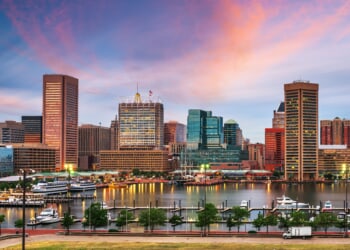Peter Franklin is an Associate Editor of UnHerd.
To write about the Conservative Party is to contemplate the void. Nevertheless, there are glimmers of hope.
One of them is the intellectual revival of British conservatism. Admittedly, most of this happening outside the formal structures of our party (or Reform UK’s for that matter), but it’s been decades since we’ve had it so good.
Take economics. Until recently, the Tory choice was between whatever George Osborne, Rishi Sunak and Jeremy Hunt thought they were doing and a pseudo-Thatcherite cargo cult. But now there’s a new and better option. Just as an earlier generation of thinkers laid the foundations for actual Thatcherism, a rising generation is building the foundations for… well, it doesn’t yet have a name, but it revolves around an ambition to tackle the root causes of the UK’s chronically low growth and the systemic failure of our public institutions.
Those leading the charge include the Looking for Growth movement, the newly relaunched Re:State think tank, and the consistently innovative Create Streets. In their various ways they’re assembling an economic agenda that the Conservatives could and should make their own: by embracing technological innovation, deep down reform of government and resistance to the politics of decay.
The new thinking also breaks with the clapped-out ideology of the libertarian think tanks. We won’t fix Britain’s fundamental problems with unfunded tax cuts, knee-jerk deregulation or by selling off what’s left of the family silver to other countries’ sovereign wealth funds. Furthermore, we don’t have to endorse Donald Trump’s trade wars to see that outsourcing the West’s manufacturing base to the Chinese Communist Party wasn’t the smartest move. The same goes for the decision to make the UK an open borders, cheap labour, bargain basement economy. If mass immigration really was the path to prosperity, then we ought to be booming by now, but quite obviously we’re not.
For further details of what needs to be done, I’d love to refer you to the speeches of the shadow cabinet. But, for the moment, I’d recommend that you delve into the blogs of Neil O’Brien and Nick Timothy instead. Why waste your time with the current party line — which has already failed — when you can get ahead of curve?
One of the most intriguing aspects of the new economic thinking is its most radical tendency — an idea which does have a name: Anglofuturism.
Before I explain what this is, I want to stress that it’s still a fringe proposition.
The mainstream of the economic reform movement is concerned with fixing the here-and-now problems of the UK economy and the British state. The Anglofuturists, however, take the ambition and optimism of their more conventional colleagues and raise it to the nth degree. They don’t just want a country that works again, they want a truly Great Britain — one that matches the economic dynamism and cultural confidence of the Victorian era, but with the cutting edge technology of the 21st century.
Thanks to the advent of AI graphics software, Anglofuturists are able to bring form to their visions. For instance, here’s a sleek maglev train sweeping through our green and pleasant land. Or how about a futuristic city of Lindisfarne? There’s apparently no limit to the Anglofuturist imagination — which at its wackiest can conjure up a galactic British Empire patrolled by patriotic death stars.
So is this just an elaborate joke — an ironic comment on the banality of our present-day politics or a gleeful up-yours to the scolds who insist we be ashamed of our history?
Well, yes — Anglofuturism is all of those things. But it has a serious side too — as explored by proper thinkers like Aris Roussinos and Richard Jones. At heart, it’s challenge to us is this: what if the great limiting factor of our national life in the 2020s isn’t slow growth or escalating debt or even demographic decline, but a smallness of vision?
Perhaps instead of worrying about next month’s inflation figures, our leading concern should be about our legacy to future generations.
I don’t mean humanity’s destruction of nature in this case, but the positive things we’ll leave behind us. Think about the Middle Ages — when our forebears devoted a seemingly insane proportion of their GDP to cathedral building. Their thoughts were on eternity of course, but what a gift they left to the present. Across Europe, cathedrals still act as focal points for urban planning, tourism and culture, as well as worship. In France the triumphant restoration of Notre Dame de Paris provided a much-needed jolt of national pride — and outshone the tawdry opening ceremony of last year’s Olympic games.
So, to rephrase the key question: is there anything that we’re building today that our descendants would bother to save from the flames? And if not, why not?
It could be argued that modernity is disposable by design. And yet, when the fancy takes, us we can build great works. Take the miracle of Singapore — which built itself up from a colonial backwater to a high tech city state in just a few decades. Or the 48,000 kilometres of high speed rail in China — most of which was built since the millennium. Or the extraordinary endeavours of Elon Musk. Even if he doesn’t achieve his ambition of dying on Mars, Musk has already revolutionised the economics of spaceflight. Meanwhile his other companies have accelerated progress on electric vehicles, robotics, satellite communications and brain/machine interfaces.
That’s not just economically important — it’s politically significant too. Musk and Trump may have fallen out, but their partnership was crucial to the outcome of last year’s presidential election. Compared to 2020 there was a huge increase in the number of young men voting Republican — from 41% to 56%. This wasn’t just a reaction against the suffocating, anti-masculine wokeness of the Democrats — it was also because Trump supporters offered an alternative, technology-driven vision of progress; for instance, in viral videos like this one, which intercuts Trumpian rhetoric with clips of SpaceX rocket launches.
Could something similar work over here? Certainly, it would take a great deal to shift our existentially dire position with young voters. And yet one can begin to sketch out a high tech, progressively patriotic agenda that might just cut through. In this regard the Anglofuturism podcast by Tom Ough and Calum Drysdale is well worth a listen.
The duo aren’t afraid to think the unthinkable, with episodes devoted to ideas like a UK space port, Britain’s “manifest destiny” in the Antarctic and reclaiming Doggerland from the North Sea. While these may count more as thought experiments than immediate propositions, such exercises encourage future-facing mental habits.
If we can contemplate the terraforming of Mars, then perhaps we’ll be encouraged to take on a less stretching objective — for instance, the terraforming of, er, Croydon. London’s least glamorous borough is not, in fact, uninhabitable — but there’s certainly room for improvement. Consider the literal waste of space between the town centre and the big box stores on the Purley Way. From East Croydon station, it’s just 15 minutes to central London and 15 minutes the other way into beautiful countryside. The area is also served by an extensive tram network. On that strength alone this should be a sought after neighbourhood. Instead, it’s a deeply uninspiring, low-density, post-war sprawl.
So are we stuck with it — and similar places — for ever? Will those down-at-heel, pebbled-dashed semis still be sat there in the 22nd century? For of all sorts of collective action problems, the answer is probably yes — and no amount of conventional planning reform will change that.
What we need, therefore, is an Anglofuturist approach to bring about the necessary change — levelling the mistakes of the mid-20th century and building a beautiful neighbourhood in its place. At sufficient (but gentle) density, we could provide the housing that young people desperately need while creating enough value to generously compensate existing residents. In other words, wins all round. Indeed, scaled up across the city, the effective size of our capital could be greatly increased without taking an inch of greenbelt or building a single tower block. Obviously, this would require a revolution in political courage and competence, but if Baron Haussmann could transform 19th century Paris, then, surely, we can do the same for 21st century London.
Though AI could help with the design and management of such a huge project, we’re not waiting for a technological breakthrough here. We just need the brains and balls to do it. And those two qualities are ultimately what Anglofuturism is about.
I’m all for making the impossible possible — but, first, let’s stop doing the opposite.



![Former Bravo Star Charged After Violent Assault Using a Rock-Filled Sock in Tennessee Walmart [WATCH]](https://www.right2024.com/wp-content/uploads/2025/07/Former-Bravo-Star-Charged-After-Violent-Assault-Using-a-Rock-Filled-350x250.jpg)



![Illegal Alien Walked Free After Decapitating Woman, Abusing Corpse for Weeks [WATCH]](https://www.right2024.com/wp-content/uploads/2025/07/1753013138_Illegal-Alien-Walked-Free-After-Decapitating-Woman-Abusing-Corpse-for-350x250.jpg)
![NYC Man Snatches Child Off The Sidewalk, Parents Chase Him Down [WATCH]](https://www.right2024.com/wp-content/uploads/2025/07/NYC-Man-Snatches-Child-Off-The-Sidewalk-Parents-Chase-Him-350x250.jpg)
![Karoline Leavitt Levels CNN's Kaitlan Collins and Other Legacy Media Reporters [WATCH]](https://www.right2024.com/wp-content/uploads/2025/07/Karoline-Leavitt-Levels-CNNs-Kaitlan-Collins-and-Other-Legacy-Media-350x250.jpg)
![Man Arrested After Screaming at Senators During Big Beautiful Bill Debate [WATCH]](https://www.right2024.com/wp-content/uploads/2025/06/Man-Arrested-After-Screaming-at-Senators-During-Big-Beautiful-Bill-350x250.jpg)






